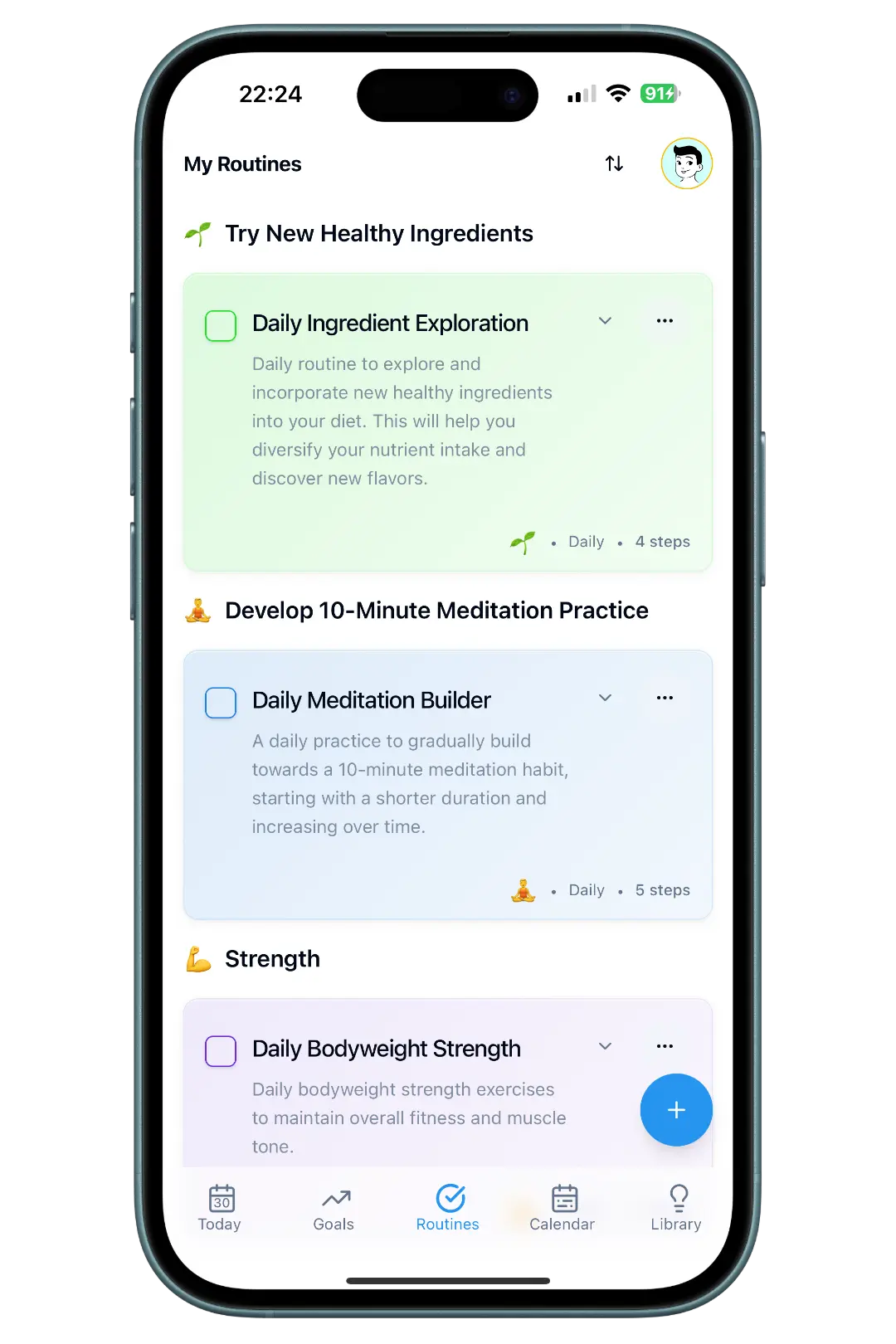
Beat Inconsistency: The Framework for Lasting Health Changes
February 9, 2025
Inconsistency is the silent killer of health transformations. You start strong, see early progress, then life happens—stress, busy periods, unexpected challenges—and suddenly you're back to square one. But what if inconsistency wasn't a character flaw but simply the result of not having the right framework? Here's the systematic approach that transforms inconsistent health attempts into lasting change.
The Inconsistency Epidemic
95% of health attempts fail within 6 months. Not because people lack willpower, but because they lack a framework that accounts for real life.
The Common Inconsistency Patterns
The Perfectionist Cycle:
- Start with ambitious goals
- Maintain perfect adherence for days/weeks
- Hit first obstacle or imperfection
- Abandon everything and start over later
The Motivation Roller Coaster:
- High motivation creates unrealistic standards
- Standards become unsustainable
- Motivation crashes, habits disappear
- Wait for motivation to return before restarting
The All-or-Nothing Trap:
- Design health routines for ideal circumstances
- When circumstances change, routines fail
- Feel like failure for not maintaining perfection
- Give up rather than adapt
The Complexity Overload:
- Try to change everything simultaneously
- Get overwhelmed by too many new habits
- Miss one element, feel like the whole system failed
- Abandon complex system for simplicity that never comes
The L.A.S.T. Framework for Lasting Health Changes
L - Layer Your Changes
Principle: Build health changes in progressive layers, mastering each before adding the next.
How It Works:
- Layer 1 (Month 1): One keystone habit
- Layer 2 (Month 2): Add complementary habit
- Layer 3 (Month 3): Expand existing habits
- Layer 4+ (Month 4+): Continue gradual expansion
Layer Implementation Strategy:
- Choose your foundation layer: The habit that will influence other areas
- Master the minimum: Practice until it feels automatic
- Stress-test the layer: Ensure it works during challenging times
- Add the next layer: Only when the previous feels effortless
Example Layering Sequence:
- Layer 1: 5 minutes daily movement
- Layer 2: One healthy meal daily
- Layer 3: Consistent bedtime routine
- Layer 4: Stress management practice
A - Adapt to Reality
Principle: Design your health system to work with your actual life, not your ideal life.
Reality-Based Planning:
- Average weeks: Standard health routine
- Busy weeks: Minimum viable routine
- Crisis weeks: Emergency maintenance routine
- Recovery weeks: Gentle return protocol
Adaptation Strategies:
Time Adaptation:
- 15 minutes available: Full routine
- 5 minutes available: Core elements only
- 2 minutes available: Symbolic minimum
- 30 seconds available: Identity reinforcement action
Energy Adaptation:
- High energy: Challenge yourself appropriately
- Medium energy: Standard routine
- Low energy: Gentle, nurturing practices
- No energy: Rest and basic self-care
Environmental Adaptation:
- At home: Full equipment and space routine
- At work: Office-friendly alternatives
- Traveling: Location-independent basics
- Limited space: Minimal equipment options
S - Systematize Your Success
Principle: Remove decision-making from your health habits through systematic design.
The 5 Systems That Eliminate Inconsistency:
1. Trigger System:
- Time-based triggers: "At 7 AM, I will..."
- Location-based triggers: "When I enter the kitchen, I will..."
- Routine-based triggers: "After I brush my teeth, I will..."
- Emotional triggers: "When I feel stressed, I will..."
2. Environment System:
- Physical cues: Visible reminders and equipment
- Removal of friction: Eliminate barriers to healthy choices
- Batch preparation: Set up multiple healthy choices in advance
- Default options: Make healthy choices the path of least resistance
3. Tracking System:
- Daily completion: Mark habits immediately in ProgressMade
- Pattern recognition: Weekly review of consistency patterns
- Course correction: Monthly system adjustments
- Celebration: Acknowledge streaks and improvements
4. Accountability System:
- Internal accountability: Identity-based commitment
- Social accountability: Share progress with supportive people
- Systematic accountability: ProgressMade check-ins and reminders
- Professional accountability: Coach, trainer, or healthcare provider
5. Recovery System:
- Same-day recovery: If you miss morning routine, do afternoon version
- Next-day recovery: Get back on track immediately, no waiting
- Weekly recovery: Plan catch-up strategies for challenging weeks
- Monthly recovery: Systematic review and system optimization
T - Track for Transformation
Principle: What gets measured gets sustained. But track the right metrics in the right way.
The 3-Layer Tracking Approach:
Layer 1: Process Metrics (Daily)
- Habit completion rates
- Energy levels (1-10 scale)
- Mood assessment
- Challenge identification
Layer 2: Leading Indicators (Weekly)
- Consistency percentages
- Pattern recognition
- System effectiveness
- Adjustment needs
Layer 3: Outcome Metrics (Monthly)
- Health improvements
- Quality of life measures
- Identity shifts
- Long-term progress
Smart Tracking Strategies:
- Immediate tracking: Log completion within 5 minutes of doing habit
- Minimal tracking: Don't let tracking become a burden
- Pattern focus: Look for trends, not daily perfection
- Celebration integration: Use tracking to celebrate wins
Implementing the L.A.S.T. Framework
Phase 1: Foundation (Month 1)
Goal: Establish one unshakeable health habit
Week 1: Layer Planning
- Choose your foundational health habit
- Design three versions: minimum, standard, optimal
- Set up environmental support
- Begin basic tracking in ProgressMade
Week 2: Adaptation Testing
- Practice your habit during typical week
- Test minimum version during busy day
- Identify friction points and obstacles
- Adjust system based on real-world feedback
Week 3: Systematization
- Establish consistent triggers and timing
- Remove remaining barriers
- Set up accountability measures
- Practice comeback protocols
Week 4: Tracking Optimization
- Review first month's data
- Identify successful patterns
- Plan for month 2 expansion
- Celebrate consistency achievements
Phase 2: Expansion (Month 2)
Goal: Add complementary habit while maintaining first
Week 5: Strategic Addition
- Choose habit that supports first habit
- Apply L.A.S.T. framework to new habit
- Ensure new habit doesn't undermine first
- Stack habits for mutual reinforcement
Week 6: Integration Testing
- Practice both habits consistently
- Monitor for system overload
- Adjust timing and approach as needed
- Maintain tracking for both habits
Week 7: System Strengthening
- Stress-test your two-habit system
- Practice adaptation during challenging week
- Refine recovery protocols
- Build confidence in your framework
Week 8: Compound Assessment
- Evaluate how habits influence each other
- Notice unexpected benefits and connections
- Plan next layer addition
- Document lessons learned
Phase 3: Mastery (Month 3+)
Goal: Continue expanding while maintaining consistency
Ongoing Framework Application:
- Add new layers only when previous feel automatic
- Continuously adapt system to life changes
- Maintain tracking and accountability systems
- Share framework with others for additional accountability
Common Framework Failures (And How to Avoid Them)
Failure 1: Skipping the Layer Process
Problem: Trying to implement multiple habits simultaneously Solution: Forced patience—master one layer completely before adding next
Failure 2: Ignoring Reality
Problem: Designing for ideal circumstances only Solution: Plan specifically for your worst-case scenarios
Failure 3: Under-Systematizing
Problem: Leaving too many decisions to willpower and motivation Solution: Pre-decide everything possible about when, where, and how
Failure 4: Tracking Obsession
Problem: Spending more time tracking than doing Solution: Minimal effective tracking—focus on trends, not perfection
Your 90-Day Framework Implementation
Days 1-30: Master L.A.S.T. framework with one foundational habit Days 31-60: Add second layer while maintaining first Days 61-90: Add third layer and evaluate compound effects
Success Metrics:
- Consistency rate above 80% for all established habits
- Successful navigation of at least one challenging period
- Automatic execution of foundational habits
- Confidence in system's long-term sustainability
The Framework Promise
When you follow the L.A.S.T. framework consistently, you'll experience:
Month 1: Increased confidence in your ability to maintain health habits Month 3: Automatic execution of multiple complementary health practices Month 6: Transformed relationship with consistency Month 12: Bulletproof health system that adapts to any life circumstance
Your Next Action
Inconsistency isn't inevitable—it's optional. The L.A.S.T. framework has helped thousands break the cycle of starting and stopping.
Start today:
- Layer: Choose your foundational health habit
- Adapt: Design minimum, standard, and optimal versions
- Systematize: Set up triggers, environment, and tracking
- Track: Log your first completion in ProgressMade
Remember: The goal isn't perfection—it's persistence. The framework works when you work the framework.
Your consistent, healthy future starts with implementing one framework element today.
What will your foundational layer be?
